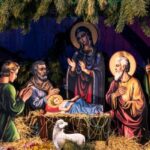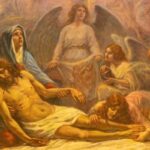We explain what a manger is, its literal meaning and its Christian meaning. Also, the history of its tradition associated with Christmas.

What is the manger?
In the West and among practitioners of the Catholic Christian religion, it is known as a manger, nativity scene, birth or portal to a plastic representation of variable size and materials of the birth of Jesus of Nazareth an event that is traditionally located in a barn, a lonely doorway or a place to feed animals.
In fact, The word manger literally designates a stable which is where, according to tradition, Jesus was born. These restagings are typical of Christmas and the celebration of Three Kings' Day, and are generally known as nativity scenes.
The mangers are stagings, in which figures or figurines take part that represent those who, according to tradition, were present at the coming into the world of the son of God: the holy family (Joseph, Mary, the baby Jesus), the archangel Gabriel and the three Wise Men who come from the East, as well as the mule and the ox.
However, it is common for other secondary or tertiary figures to also appear in larger nativity scenes, such as shepherd boys with their flocks, walkers, dancers, angels, etc.
The preparation of nativity scenes is usually the responsibility of families, parish religious communities or educational and/or public institutions. Competitions are frequently held to reward the best representation of the birth. Furthermore, these vary immensely from one version to another. Thus, there may be nativity scenes painted, sculpted, in relief, with real actors, etc.
The tradition of the manger is extremely old. There is evidence of its composition in catacombs of early Christianity, and also in ancient churches and pilgrimage sites of Christian worship.
However, The first recorded Christmas nativity scene was made on Christmas Eve in 1223 by Saint Francis of Assisi inside a cave near Greccio, in Italy. On that occasion, the saint used animals instead of actors or figures, to symbolize the birth of Christ, and later celebrated a night mass.
The Franciscan order, in fact, was one of the great promoters of nativity scenes in the centuries to come. Starting in the 14th century, this tradition became widespread in Italy and other European countries, first as a practice carried out by ecclesiastical authorities, then also by aristocrats and finally as a popular tradition.
The mangers were even used as a tool of evangelization in Hispanic America throughout the 18th century, incorporating local plant and animal species into its representation.
Already in the 19th century, nativity scenes were so popular that the first Nativity Scene Associations emerged in Europe, and specialized conferences were even held on the subject. However, today it is considered a way to freely express the Catholic faith and celebrate the arrival of the Christmas holidays. For this reason, the current customs around the manger are many and varied.
According to tradition, The manger is set up before Christmas, generally on December 8 feast of the Immaculate Conception, and It is left standing until February 2 Candelaria festival.
It is also common to hide the baby Jesus at first with a piece of cloth (or in some cases physically remove him from the scene), until after midnight on December 24, when he is revealed or made present, since it is considered that by end Jesus Christ “is born.”
Continue with: Religious norms
References
- “Manger” in Wikipedia.
- “Nativity Scene” on Wikipedia.
- “The meaning of the manger” (video) on Síntesis TV.
- “Manger or grotto: the brief phrase of a saint who revealed what the place where Jesus was born was like” in Infobae (Argentina).
- “The untold story of the manger” in Clarín (Argentina).
- “Manger” in the Dictionary of the language of the Royal Spanish Academy.





